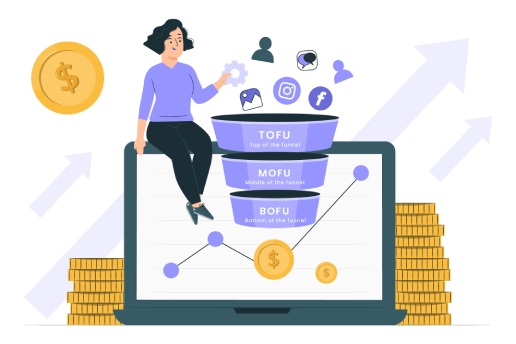Digital marketing has revolutionized the world of business in general and advertising in particular. The effective use of digital marketing tools & strategies can deliver phenomenal growth to any business – large or small. But it all depends upon your skill, knowledge, and expertise in the domain. While the resources are available in abundance, what matters is how best you can utilize them to achieve your goals & objectives.
One such popular tool that is widely used in digital marketing is the marketing funnel. What does it mean? You also get to hear the terms like upper funnel advertising and lower funnel advertising. What are they? A clear understanding of the funnel concept, its objective, and how it works is fundamental to the success of any digital marketing campaign. It provides invaluable insights into customer behavior.
What is a Marketing Funnel?
A marketing funnel is a model that guides the entire journey that a customer takes, right from the moment he gets to know the brand until he converts or becomes a customer. So the marketing funnel is also called a conversion funnel. The term funnel denotes the gradual reduction in the number of people who proceed further to take action. Before getting onto the upper funnel vs. lower funnel advertising, it is important to understand the basic structure. A marketing funnel is typically based on the A.I.D.A framework that is.
- Attention: The first time a prospective customer hears about your brand from an ad, a social media post, or a personal conversation with a friend
- Interest: The prospect displays an interest in your product or service as he thinks that it can solve his problem
- Desire: The prospect tries to gather more information about your product and is keen to convert
- Action: The prospect takes the intended action – buys the product, signs up for the free webinar, fills the form, subscribes to the newsletter, etc
The AIDA model can also be visualized as a 3-stage process consisting of the upper funnel, middle funnel, and lower funnel advertising.
- Upper Funnel or Top of the Funnel: The prospect has just identified a need or a problem and is actively looking out for a solution. During the course of his research, he may stumble upon or get to know your brand or product.
- Middle Funnel: The prospect is now aware of the potential offerings in the marketplace. Based on his needs, budget, and expectations, he may draw up a list of a few suitable products.
- Lower Funnel or Bottom of the Funnel: The prospect has made up his mind based on reviews, referrals, offers, etc. He converts or takes the desired action.
Different Stages of the Marketing Funnel
The strategies and techniques shall be different for upper funnel marketing compared to the middle and lower ones. A detailed description of the key funnel stages will provide a better understanding and clarity to adopt the most effective approach.
1) Upper Funnel:
The top of the funnel corresponds to the awareness stage. The prospects have just become aware of your brand, but they are yet to dig deep for the details. It is the first time that they are getting associated with you. So the entire marketing approach should be directed toward enhancing brand awareness and attracting as many leads as possible.
You can engage more with your prospective customers by using one or more of these strategies for upper-funnel advertising:
- Creating educational content in the form of blog posts & simple infographics
- Distributing free eBooks in exchange for the contact details of the prospects
- Regular social media posts across different channels
- Organic marketing through SEO and video content
- Spending on paid ads, signing up for free webinars, podcasts, etc.
2) Middle Funnel:
Once you are fairly successful in advertising your brand presence in the target market, your prospective customers enter the middle of the funnel or the consideration stage. They may now start following you regularly on social media, attend your webinars, subscribe to your email list, etc.
Since the prospects have started to engage with you meaningfully, it can be said that they are actively considering your product or service. The time is now ripe to earn their trust by providing content that aligns with this stage. Now the right tactics can be any of the following.
- Sharing relevant case studies with the prospects to highlight the value of your products or services
- Publishing well-researched white papers of your offerings that are more detailed in coverage than the case studies
- Lead nurturing through email marketing
- Social media marketing (focussed around specific features of your products or services)
3) Lower Funnel:
You have firmly established your brand in the minds of the prospects. The goal of lower funnel advertising is to convert them or close the deal. Now it’s your responsibility to guide their decision-making process. Convince them that you are the best of the lot by giving specific reasons.
Please note that the bottom of the funnel will be very narrow. A lot of prospects have already dropped out of the funnel at the earlier stages. But the few who remain are highly qualified to become your customers. Some of the lower-funnel marketing tactics to be adopted are listed below.
- Offering a free product demo or trial for a limited period of time
- Sharing social proof like testimonials and reviews of successful customers
- Targeted paid ads are also an effective lower-funnel marketing strategy
- Offering special discounts & offers to prospects who exit the shopping cart without purchasing
- Sending a customized mail that addresses the specific queries & issues of the prospects
- Offering a no-questions-asked 100% refund to allay the fears of indecisive prospects

Importance of Marketing Funnels
If you believe that you have the best product and yet your business is not growing as it should be, it’s time to set right the marketing funnel. This could very well be a game changer and turn around the business in a short time span. A marketing funnel can provide the following benefits.
- The most important benefit of a marketing funnel is the availability of data points to measure, quantify, and assess your marketing strategy. If prospects are dropping out at any stage, you can figure out the reasons.
- It helps you to nurture leads through an upper-funnel marketing strategy. Without the funnel, prospects may soon forget about your offer, and you end up losing them.
- A funnel helps you to clearly understand and analyze customer behavior. It tells you why they do what they do, and you can figure out what best to do.
- Marketing funnels help to enhance your brand awareness, deepen customer engagement levels and spread the brand message in a competitive marketplace.
- Funnels can help you save precious time, money, and effort as compared to the traditional marketing approach.
- Customer engagement activities can help to retain your existing customers. Customer retention is 4-5 times cheaper than customer acquisition.
Analyzing the results of the lower-funnel advertising strategy tells you the reasons why prospects convert. This enables you to predict future sales with near accuracy.
Conclusion
A marketing funnel effectively captures the mind of the consumers at various stages, beginning with getting to know the brand till they become its loyal customers. A funnel attracts prospects at the top, engages them in the middle, and ultimately converts them at the bottom. It is a graphical representation of the entire customer journey.
Going beyond the upper-funnel vs. lower-funnel advertising, the leading organizations are now embracing the full-funnel marketing approach. This model gives marketers a holistic view of their marketing efforts. As potential customers require different approaches based on their location in the funnel, a full-funnel marketing strategy can suitably adjust the strategies.








